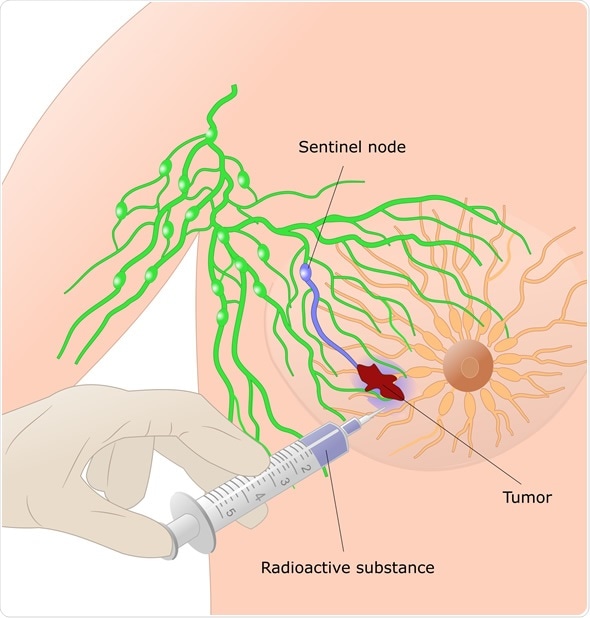
Sentinel Lymph Nodes
The lymphatic system is a specialized transport network in the body much like the circulatory system. The lymphatic system is composed of:
- Lymphatic vessels
- Lymph nodes
- Two lymphatic (collecting) ducts
Lymphatic vessels are thin-walled vessels generally larger than capillaries but smaller than many veins. Like veins, they also have valves to allow unidirectional lymph flow.

Breast cancer: finding the sentinel node before surgery - Image ID Copyright: ellepigrafica / Shutterstock
The lymph vessels drain interstitial fluid from tissues in the body. This is fluid which has diffused through the thin capillary walls and is replete with proteins, oxygen, glucose, and other substances in plasma. In addition it contains other substances such as numerous waste products. Whilst the majority of this fluid re-enters the capillaries, some is collected by the lymph vessels. This fluid is then referred to as lymph.
The lymph travels in the lymph vessels and must eventually pass through lymph nodes. The lymph nodes are clustered in areas such as the neck, groin, and under arms, where the lymph vessels branch off. The lymph nodes are organs designed to detect and filter various particles out of the lymph before the lymph is emptied into the venous circulation via the lymphatic ducts in the neck. These include antigenic particles, damaged cells, and cancer cells. The lymph nodes are also an important component of the immune system. They contain specialised immune cells such as B and T lymphocytes, dendritic cells, and macrophages. When these cells detect the presence of antigens (from bacteria and viruses), they become activated and trigger an immune response.
Lymph nodes are vital in determining whether cancer cells have developed the ability to metastasize. As many forms of cancer spread via the lymphatic system to distant spots in the body, this is an important function of lymph nodes.
A sentinel lymph node is defined as the first lymph node cancer cells are most likely to spread to from a primary tumor. It is the first affected node because it is the earliest or most proximal node with respect to receiving lymph fluid from the vicinity of the tumour. There may be more than one sentinel lymph node, depending on both the location of the tumor and the network of surrounding lymph vessels.
A sentinel node biopsy (SNB) is used to evaluate the extent of spread of a cancer from the primary tumor to the lymph nodes. This is most commonly used in cases of breast cancer. The sentinel nodes here are often the axillary lymph nodes located under the armpits.
By determining whether metastasis of the primary tumor has occurred, an SNB can help gauge the stage of cancer to and aid in the planning of its treatment according to the results.
The SNB procedure itself involves the injection of a radioactive tracer and/or a visible dye into the tissue surrounding the tumor. These allow the visualization of the sentinel node so that it can be excised and examined.
In the case of breast cancer, the tracer and/or dye may be injected under the areola (the dark area of the breast which surrounds the nipple) and 1-3 of the axillary lymph nodes are removed for analysis.
References
- http://www.cancer.gov/about-cancer/diagnosis-staging/staging/sentinel-node-biopsy-fact-sheet
- http://www.cancerresearchuk.org/about-cancer/type/breast-cancer/treatment/surgery/types-of-breast-cancer-surgery
- http://www.cancer.net/research-and-advocacy/asco-care-and-treatment-recommendations-patients/sentinel-lymph-node-biopsy-early-stage-breast-cancer
- http://www.macmillan.org.uk/information-and-support/coping/side-effects-and-symptoms/lymphoedema/what-is-the-lymphatic-system.html#3676
- http://www.cancer.org/cancer/cancerbasics/lymph-nodes-and-cancer
Further Reading
Last Updated: Aug 23, 2018






















.jpg)










No hay comentarios:
Publicar un comentario